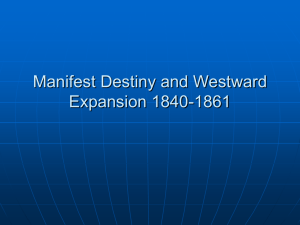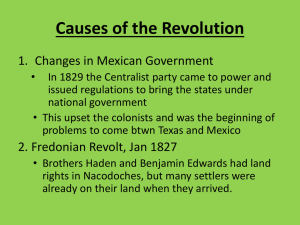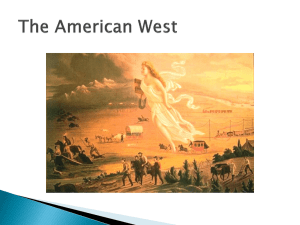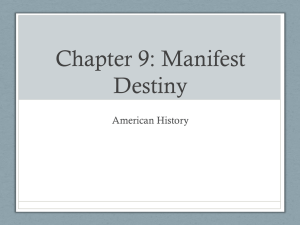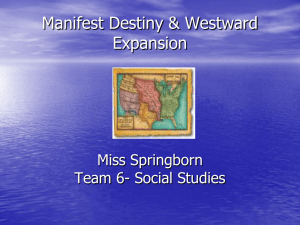File - History? Because it`s Here!
advertisement
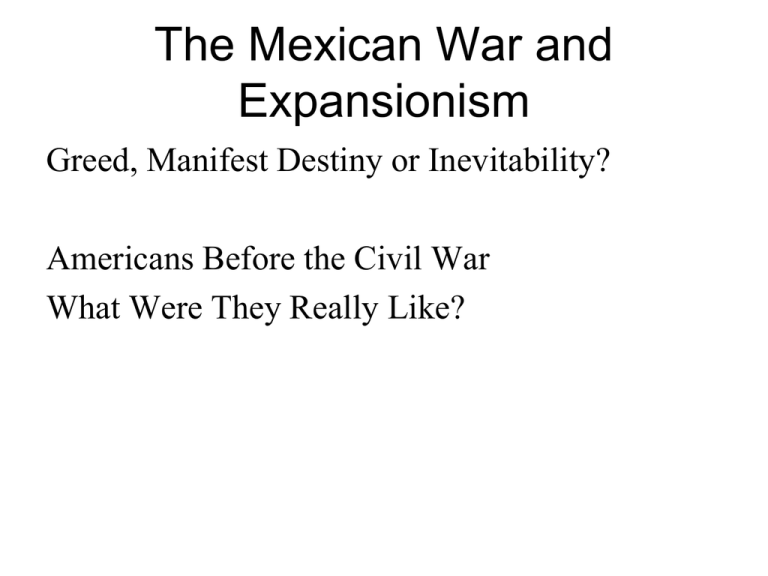
The Mexican War and Expansionism Greed, Manifest Destiny or Inevitability? Americans Before the Civil War What Were They Really Like? • In April 1841, John Tyler inherited the presidency from William Henry Harrison who had contracted pneumonia and died a month after his inauguration. • William Henry Harrison had been a Whig and President John Tyler was a Democrat. • After the victory of Whig William Henry Harrison in the 1840 election the Whig party anticipated re-chartering a federal bank, raising the tariff, and carrying out other nationalist measures. • After Tyler became president, true to his state’s rights principles he vetoed the bank bill. • The entire cabinet except for Daniel Webster resigned in protest and Tyler and the Whig leaders in Congress remained stalemated. • Tyler fared better in foreign affairs. He and Secretary of State Daniel Webster managed to negotiate the 1842 Webster-Ashburton Treaty that settled and American-Canadian border dispute. • The United States also agreed to join Britain in supporting a naval squadron stationed off the African coast to capture slave ships attempting to bring slaves to the Americas. • President Tyler also settled the Oregon dispute. Many Americans insisted that the United States rightfully owned all of the Oregon country. Tyler offered to divide Oregon with the British at the 49th parallel. He offered the British San Francisco, which they declined. • President Tyler’s major foreign policy success came in Texas. • Americans had crossed into the Spanish-held territory of Texas early in the 19th century. • In 1820, the newly independent Mexican Republic gave Moses Austin a land grant and the right to settle 300 American families as permanent citizens. • In 1823 Stephen Austin, Moses’ son, established the first American colony in east Texas. • By 1825 there were 1,800 colonists, including 443 slaves. • By 1835, about 20,000 transplanted Americans were living in Texas. • There were tensions between Americans and Mexicans. The Americans were mostly Protestant and resented the efforts of Mexican officials to convert them to the Catholic faith. • Most of them were southerners determined to grow cotton with slave labor and they resisted Mexican laws forbidding slavery. • Many transplanted American felt Mexicans were culturally or racially inferior. • Despite these feelings, American settlers in Texas proved loyal to Mexico. • Many Americans regretted the surrender of Texas to Spain in the Adams-Onis Treaty of 1819. The United States tried to buy Texas back, but failed. • The Mexican government produced constant changes of policy and turmoil. • Matters came to a head under the presidency of Antonio Lopez de Santa Anna. • In 1835 Santa Anna marched north with his army to punish the Texans. Challenging him were 187 Texans at the Alamo, an adobe walled former mission in San Antonio, Texas. • In late February 1836, Santa Anna and 4,000 troops arrived at San Antonio and surrounded the American force. On March 6, the Mexicans overwhelmed the Americans who were all killed. • Texas declared its independence and named Sam Houston commander in chief of the Texas Army. It created a constitution that recognized slavery and granted each citizen land. • On April 26, 1836, Sam Houston and his troops attacked the Mexicans at San Jacinto and decisively defeated them. • Texas proclaimed itself an independent republic. • As soon as Texas achieved its independence it sought to be admitted to the United States. • Americans were divided over the admission to Texas to the Union. Whigs traditionally opposed expansion and many northerners feared that Texas would enter the Union as a slave state. • Early in 1837, just before he left office President Jackson had granted diplomatic recognition to the Texas Republic. • For the next few years Texas functioned as a Republic. Texas or the Lone Star Republic, began to negotiate with France and Britain which alarmed Americans. • President John Tyler finally signed the joint resolution for Texas to join the union in the last hours of his administration. Texas entered the Union as a slave state in December 1845, but only after another heated debate in Congress with anti-slavery Whigs leading the opposition. The Causes of the Mexican War 1846-1848 • There are different theories about the origins of the Mexican War. Illinois Congressman Abraham Lincoln thought the war as naked United States aggression against a weaker neighbor. • Writers like Henry David Thoreau saw it as a southern slave holders plot. • Some scholars view the war as an expression of manifest destiny or American cultural, political, and racial superiority over the American continent. • Mexican scholars see the war as a result of America’s greed and blatant aggression. • Another school of interpretation sees the war as inevitable American expansion of history and geography. • The Mexican government had threatened to retaliate against the United States if it absorbed Texas. • The new president, James K. Polk, had expansionist territorial goals but he did not want to go to war to achieve them. • President Polk proposed a settlement of the Oregon question that had dragged on since the days of John Quincy Adams a generation before. Finally, in June 1846 the Oregon question was settled. • The United States-Canadian boundary extended beyond the Great Lakes along the forty-ninth parallel to the Pacific and all of Vancouver Island would remain British. • By the time the Senate approved the Oregon treaty, Americans and Mexicans were killing each other along the entire border from Texas to California. The Slidell Mission • In the fall of 1845, President James K. Polk sent John Slidell to Mexico on a diplomatic mission. • Slidell was to say that if Mexico recognized the Rio Grande as the southwestern boundary of Texas, the United States would pay the $3.25 million that Mexico owed to American citizens as compensation for disorders and defaults in Mexico. • Slidell was authorized to offer another $5 million for New Mexico and $25 million for California. President Polk told Slidell that if these negotiations failed, he would ask Congress “to provide proper remedies,” which most likely was a threat of war. • The president of Mexico was inclined to negotiate, but news of Slidell’s mission leaked out and the Mexico public opinion was hostile. • Slidell was permitted to enter Mexico but was not allowed to present his proposals. • Shortly after Slidell arrived in Mexico, the Federalist Herrera government fell and the new Centralist administration sought to pursue a war. New president Mariano Paredes began to negotiate with Great Britain for support against the United States if it came. • President Polk ordered General Zachary Taylor to move his troops to the north bank of the Rio Grande to occupy the disputed Texas border region and protect Texas against possible attack. • By the spring of 1846 both President Polk and the Americans and the Mexican president and people concluded that war was inevitable. • The Mexicans were confident that Britain would support them, that New England and abolitionist opposition would hamper the war effort, and that the Mexicans man for man, were better soldiers than the Americans. • On April 23, 1846, President Paredes announced that Mexico had declared “defensive war” on the United States. • Mexican troops crossed the Rio Grande and attacked a unit of General Zachary Taylor’s army. In May 1846, President Polk’s war message was read to Congress and the Senate declared war by a vote of 40-1 and the House by a vote of 174-14. • Young American men flocked to recruiting offices and the combination of a small regular army and a mass of volunteers worked well. • The country enjoyed excellent wartime morale. • It also enjoyed skilled military leadership, with a group of well trained officer from West Point. • Zachary Taylor and his troops took much Mexican territory such as Matamoras and Monterrey. Conquest of California • In 1845 President Polk had secretly authorized the American consul in the California capital to help stir up a secessionist movement. • In the meantime a group of Americans had proclaimed the Republic of California and Captain John C. Fremont arrived in California with a contingent of American troops. On July 1, Fremont occupied the Mexican fort at San Francisco while the Mexican government fled to Los Angeles. • All of southern California was in Mexican hands when Stephen Kearny arrived outside of San Diego with his small force of men. He and Robert Stockton and their forces retook southern California and joined with Fremont. On January 13, the Mexican forces signed the Capitulation of Cahuenga and the province of California was now American. • Zachary Taylor and Winfield Scott occupied Mexico and captured Mexico City. Finally Santa Anna fled, leaving the surrender and peace negotiations to the ad interim president, Pedro Anaya. • On February 2, 1848, Mexico signed the Treaty of Guadalupe Hildago with the United States. • The Treaty gave the United States the provinces of California and New Mexico. • The Treaty of Guadalupe Hidalgo confirmed the Rio Grande as the southwestern boundary of Texas. • The Mexican Cession included the present states of California, Nevada, and Utah, and parts of Arizona, New Mexico, Wyoming, and Colorado. • In return, the United States agreed to pay Mexico $15 and to assume the $3.5 million of American citizens’ claims against the Mexican government. • The Mexican War lasted almost two years and cost 13,000 American lives and $100 million. • The Mexican War was the last phase of continental expansion that extended the country to the Pacific Ocean. The Mexican War added 530,000 square miles to the United States. • The settlement of the Oregon boundary dispute with Great Britain added another 258,000 square miles. Americans Before the Civil War What Were They Really Like? The Moving Frontier • Generations of American scholars have seen the west as the key to the American character and institutions. • After 1815, the West or the region beyond the Appalachians, was the fastest growing part of the United States. • During this time the west became the home of 15 million Americans. • At the beginning of the Civil War, American have over 31 million people and half of them lived in states and territories where white communities had not existed when General George Washington was inaugurated. • Americans generally moved west along lines of latitude. • Indians were continually pushed westward ahead of the flood of white and black settlers. The Migrants’ Motives • Some people were the “loners” who could not stay put once they had seen the smoke of their neighbor’s fire. • Some were refugees fleeing the law, their creditors, their spouses, their pasts. • Some followed spouses and parents. • Many single women thought of the west as the land of opportunity and emigrated there. • Economic considerations called most people West. • Historian Frederick Jackson Turner believed that the west transformed immigrants and was “productive of individualism…” • He thought the west discouraged governmental control and was egalitarian. The west was also free of materialism, according to Turner. • Turners agreeable, positive picture of the West is an overstatement. Real westerners were crude, more materialistic, and less egalitarian and individualistic in their behavior than Turner claimed. Problems of Urbanization • In 1800 only five towns in America had over 10,000 people- New York, Philadelphia, Boston, Charleston and Baltimore. • As the economy changed and grew, new factories and mills attracted many people to the older towns and created new ones. • Housing was a major urban problem and never adequately solved. • As well as poor housing, cities were plagued with the ills of poor water supply, poor waste disposal and poor health services. • Crime and violence were also social ills that increased with urbanization. • Between 1830 and 1860 violent confrontations between immigrant Catholics and militant native Protestants took place in American cities. Immigration • During the 50 years after the Revolution, immigration to American from Europe had been light. • Then in the 1830s, the number of new immigrants in America grew to almost 600,000. In the 1840s, it grew to 1.7 million and in the 1850s, 2.3 million. • Most of the immigrants were from Britain, Germany, and the southern part of Ireland. Free Blacks • Race, even ore than religion and nationality, challenged America’s egalitarian ideas. • 200,000 free blacks lived in the northern and western states in 1850. • Bigotry harshly affected the life of almost every free black. They were denied admission to white schools, refused jobs, and deprived of basic civil rights. Women • America before the Civil War was male dominated. It was difficult for any woman to life independently of a man and all of the professions except teaching were closed to them. • Under the law the earnings and property of a married woman belonged to her husband. • In a divorce, women usually lost all claim to their children. • Women could not hold office or vote. The Arts in Antebellum America • Washington Irving and James Fenimore Cooper produced the first distinguished national American literature. • The South produced Edgar Allen Poe and New England the Transcendentalists, and New York Herman Melville. Walt Whitman was also a writer and poet of distinctly American character. Reform Movements in America • Religious Reform • Temperance • Women’s Rights • Anti-Slavery • Utopian Socialism Conclusions • Americans were competitive and individualistic. • They were crude, bad-manned, violent and bigoted. • They were also humane, romantic, creative, and socially speculative. They were a people of paradox. • Unger says that all changes in America followed lines of latitude. • The entire region north of Dixie was in a state of unusual transition. • There were antagonisms between East and West, but Easterners continually moved West and became like the Westerners they had deplored. • By 1860 the Northeast and Northwest resembled each other more than they did the South. • This development of distinctive North-South sectional identities would soon have momentous consequences for the American nation.
